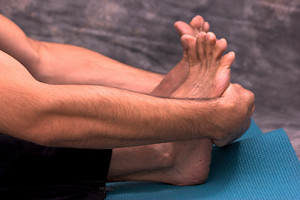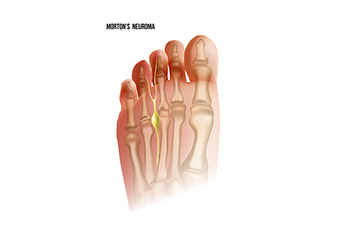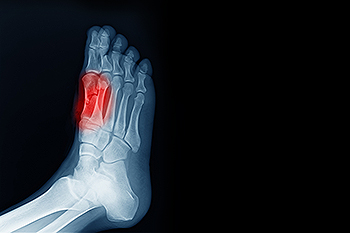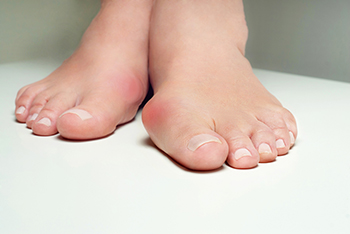Connect With Us
Blog
Items filtered by date: December 2023
Effective Stretches for Improved Heel Stability

Heel stability is an important aspect of overall balance and comfort, and it is often overlooked until you experience pain or discomfort in that area. Fortunately, there are several stretches that can help enhance heel stability and promote overall foot health. One beneficial stretch is the calf stretch. This simple exercise involves extending one leg behind you and leaning forward with the other, feeling the stretch in your calf and Achilles tendon. By keeping these areas flexible, you reduce the strain on your heel. Another effective stretch is the plantar fascia stretch. To perform this, sit down and cross one ankle over the opposite knee. Gently pull your toes back toward your shin, feeling the stretch along the arch of your foot. This stretch helps to maintain the flexibility of the plantar fascia, thus reducing the risk of heel pain. The final stretch to consider is the toe stretch. This can be done by sitting or standing and extending your toes as far as possible, then curling them under. This exercise strengthens the muscles in your feet and enhances overall heel stability. If you would like additional information about effective heel stability stretches, it is suggested that you speak with a podiatrist who can provide you with the knowledge you are seeking.
Why Stretching Is Important for Your Feet
Stretching the feet is a great way to prevent injuries. If you have any concerns with your feet consult with one of our podiatrists from Podiatry Inc.. Our doctors will assess your condition and provide you with quality foot and ankle treatment.
Stretching the Feet
Stretching the muscles in the foot is an important part in any physical activity. Feet that are tight can lead to less flexibility and make you more prone to injury. One of the most common forms of foot pain, plantar fasciitis, can be stretched out to help ease the pain. Stretching can not only ease pain from plantar fasciitis but also prevent it as well. However, it is important to see a podiatrist first to determine if stretching is right for you. Podiatrists can also recommend other ways to stretch your feet. Once you know whether stretching is right for you, here are some excellent stretches you can do.
- Using a foam roller or any cylindrical object (a water bottle or soda can will do), roll the object under your foot back and forth. You should also exert pressure on the object. Be sure to do this to both feet for a minute. Do this exercise three times each.
- Similar to the previous exercise, take a ball, such as a tennis ball, and roll it under your foot while seated and exert pressure on it.
- Grab a resistance band or towel and take a seat. If you are using a towel, fold it length wise. Next put either one between the ball of your foot and heel and pull with both hands on each side towards you. Hold this for 15 seconds and then switch feet. Do this three times for each foot.
- Finally hold your big toe while crossing one leg over the other. Pull the toe towards you and hold for 15 seconds. Once again do this three times per foot.
It is best to go easy when first stretching your foot and work your way up. If your foot starts hurting, stop exercising to ice and rest the foot. It is advised that you then see a podiatrist for help.
If you have any questions, please feel free to contact our offices located in Beachwood, Mayfield Heights, Mentor, and Tallmadge, OH . We offer the newest diagnostic and treatment technologies for all your foot care needs.
Signs of Morton's Neuroma

Morton's neuroma, a nerve disorder affecting the ball of the foot, manifests through distinctive symptoms that can disrupt daily life. Characterized by a thickening of the tissue surrounding the nerves leading to the toes, this condition triggers a variety of discomforts. Individuals with Morton's neuroma commonly experience a sensation of having a pebble or fold in their shoe, coupled with pain or numbness in the toes. Pain typically intensifies during weight-bearing activities, such as walking or standing, and wearing tight or narrow shoes may exacerbate symptoms. The discomfort may radiate from the ball of the foot to the toes, and some individuals describe a burning or tingling sensation. As the condition progresses, affected individuals may notice an increase in the frequency and duration of symptoms. If you have pain between the toes, it is suggested that you speak with a podiatrist who can diagnose and treat Morton’s neuroma.
Morton’s neuroma is a very uncomfortable condition to live with. If you think you have Morton’s neuroma, contact one of our podiatrists of Podiatry Inc.. Our doctors will attend to all of your foot care needs and answer any of your related questions.
Morton’s Neuroma
Morton's neuroma is a painful foot condition that commonly affects the areas between the second and third or third and fourth toe, although other areas of the foot are also susceptible. Morton’s neuroma is caused by an inflamed nerve in the foot that is being squeezed and aggravated by surrounding bones.
What Increases the Chances of Having Morton’s Neuroma?
- Ill-fitting high heels or shoes that add pressure to the toe or foot
- Jogging, running or any sport that involves constant impact to the foot
- Flat feet, bunions, and any other foot deformities
Morton’s neuroma is a very treatable condition. Orthotics and shoe inserts can often be used to alleviate the pain on the forefront of the feet. In more severe cases, corticosteroids can also be prescribed. In order to figure out the best treatment for your neuroma, it’s recommended to seek the care of a podiatrist who can diagnose your condition and provide different treatment options.
If you have any questions, please feel free to contact our offices located in Beachwood, Mayfield Heights, Mentor, and Tallmadge, OH . We offer the newest diagnostic and treatment technologies for all your foot care needs.
Join Us in Welcoming Dr. Cory Jarosi to Our Podiatry Family
 Dr. Cory Jarosi, the latest addition to the Podiatry Inc. team, graduated
Dr. Cory Jarosi, the latest addition to the Podiatry Inc. team, graduated
from Kent State College of Podiatric Medicine and completed his podiatric
residency at Mercy Regional Medical Center in Lorain, OH.
Embracing the diversity within the podiatric field, Dr. Jarosi finds the
intricacies of foot anatomy intriguing. Given that the bones in the feet
constitute approximately 25% of the body's total bones, he is continually
motivated to tackle new challenges. Drawing on his experience as a
collegiate athlete, he has a particular passion for addressing athletic or
sports injuries, relishing the complexity of trauma cases, and aiding
elderly patients in their journey to regain mobility.
Originally from Perrysburg, OH, Dr. Jarosi now calls Broadview Heights, OH,
his home. During his leisure time, he cherishes moments with his family and
engages in the joy of cooking alongside his wife.
The Function of the Sesamoid Bones in the Feet

Sesamoid bones are tiny bones that are found near joints within muscles or tendons. They act like pulleys to reduce stress on these muscle-tendon areas. Unlike regular bones that connect at joints, sesamoid bones connect to muscles using tendons. The word sesamoid comes from the Arabic word sesamum, which means sesame, because they are small like sesame seeds. These bones are often in the foot, hand, and wrist. Sesamoid bones usually develop due to extra strain on muscles and tendons. Their main job is to ease tension in muscles and tendons, making them better at carrying weight and more resilient by distributing it evenly. This helps protect these various parts of the body from getting too strained or injured. Even though they are small, sesamoid bones are vital in how our bodies work. If you have pain in your feet corresponding to the location of these bones, it is suggested that you schedule an appointment with a podiatrist for a proper diagnosis and treatment
Sesamoiditis is an unpleasant foot condition characterized by pain in the balls of the feet. If you think you’re struggling with sesamoiditis, contact one of our podiatrists of Podiatry Inc.. Our doctors will treat your condition thoroughly and effectively.
Sesamoiditis
Sesamoiditis is a condition of the foot that affects the ball of the foot. It is more common in younger people than it is in older people. It can also occur with people who have begun a new exercise program, since their bodies are adjusting to the new physical regimen. Pain may also be caused by the inflammation of tendons surrounding the bones. It is important to seek treatment in its early stages because if you ignore the pain, this condition can lead to more serious problems such as severe irritation and bone fractures.
Causes of Sesamoiditis
- Sudden increase in activity
- Increase in physically strenuous movement without a proper warm up or build up
- Foot structure: those who have smaller, bonier feet or those with a high arch may be more susceptible
Treatment for sesamoiditis is non-invasive and simple. Doctors may recommend a strict rest period where the patient forgoes most physical activity. This will help give the patient time to heal their feet through limited activity. For serious cases, it is best to speak with your doctor to determine a treatment option that will help your specific needs.
If you have any questions please feel free to contact our offices located in Beachwood, Mayfield Heights, Mentor, and Tallmadge, OH . We offer the newest diagnostic and treatment technologies for all your foot and ankle needs.
Understanding the Definition and Causes of a Bunion

A bunion, a common foot deformity, is characterized by the gradual misalignment of the big toe joint, causing a bony protrusion on the side of the foot. This condition develops when the big toe consistently pushes against the next toe, gradually altering the joint's structure. Wearing ill-fitting footwear, particularly tight shoes or high heels, is a primary culprit, as they force the toes into unnatural positions. Genetic factors also play a role, with some individuals inheriting a predisposition to bunions. Foot mechanics, such as overpronation or flat feet, contribute to the misalignment, increasing the risk. Arthritis, particularly inflammatory types, may exacerbate bunion formation. Additionally, trauma or injury to the foot can accelerate the development of bunions. Recognizing the multifaceted causes of bunions is important for preventive measures. If you have developed a bunion, it is suggested that you schedule an appointment with a podiatrist who can offer you effective relief techniques.
If you are suffering from bunion pain, contact one of our podiatrists of Podiatry Inc.. Our doctors can provide the care you need to keep you pain-free and on your feet.
What Is a Bunion?
Bunions are painful bony bumps that usually develop on the inside of the foot at the joint of the big toe. As the deformity increases over time, it may become painful to walk and wear shoes. Women are more likely to exacerbate existing bunions since they often wear tight, narrow shoes that shift their toes together. Bunion pain can be relieved by wearing wider shoes with enough room for the toes.
Causes
- Genetics – some people inherit feet that are more prone to bunion development
- Inflammatory Conditions - rheumatoid arthritis and polio may cause bunion development
Symptoms
- Redness and inflammation
- Pain and tenderness
- Callus or corns on the bump
- Restricted motion in the big toe
In order to diagnose your bunion, your podiatrist may ask about your medical history, symptoms, and general health. Your doctor might also order an x-ray to take a closer look at your feet. Nonsurgical treatment options include orthotics, padding, icing, changes in footwear, and medication. If nonsurgical treatments don’t alleviate your bunion pain, surgery may be necessary.
If you have any questions, please feel free to contact our offices located in Beachwood, Mayfield Heights, Mentor, and Tallmadge, OH . We offer the newest diagnostic and treatment technologies for all your foot care needs.

